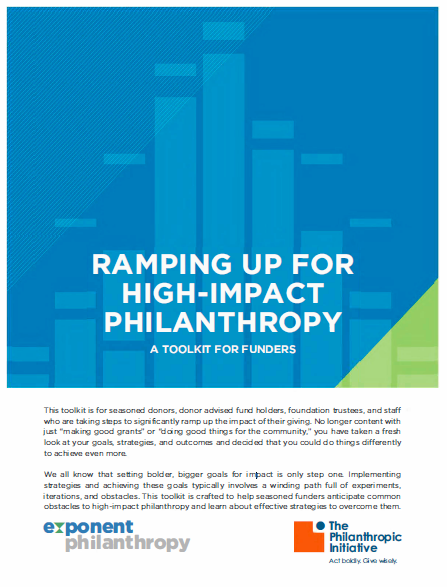This post is part of the Ramping Up for Impact blog series, which digs deeper into topics explored in the primer by The Philanthropic Initiative (TPI) and Exponent Philanthropy, Ramping Up Your Foundation: Key Considerations for Planning and Managing a Significant Increase in Giving.
—
The ramp-up period in a foundation’s life cycle is an exciting time. Additional resources often allow foundation leadership to think and act in new ways, fueled by a sense of the possibilities for funding new grantees, onboarding new trustees and staff, making new investments in foundation infrastructure, and exploring new strategic directions. One of the lessons of our research with foundation leaders—shared on page 2 of the report, Ramping Up Your Foundation—was that along with focusing on all the “newness” that comes with the ramp-up process, foundations need to take time early on in the process to fully understand donor intent. While ramping up often takes place as a result of a donor’s passing, the influence of the donor is by no means at an end.
Donors vary considerably in the specificity and intentionality of their “donor intent”. Of course, some are very explicit about how they would like or even require successor trustees to steward the assets after their passing, with carefully crafted legal documents or side letters that specify recipients and issue areas. Many of the donors we work with are happy for the succeeding trustees to make choices based on the needs of the times, and are confident they will make good ones. Naturally, a number of founding donors fall somewhere in the middle, choosing to advise successors on their broad areas of interest and strongly held values through informal conversations, family engagement in the foundation, or personal correspondence.
What was fascinating in our research was the fact that just about all successor trustees – even those whose donors had decided to let them fully shape the next phase – found immense value in ensuring there was a shared understanding of donor intent and developing a strategy for the future that celebrated and honored the donor, was respectful of legacy grantee relationships, and was rooted in the donor’s values.
Foundation boards with foresight can take a number of steps to ensure this transition goes smoothly. If the donor wishes that certain instructions are to be followed, the best path will be to work with the foundation or estate attorney to establish legal parameters. Many choose to write donor intent letters or donor legacy statements. TPI and Personal Legacy Advisors created the Across Generations workbook for just this purpose. Some boards will commission video histories or interviews with their donor, even asking media-savvy next generation members to oversee the process. Books that celebrate the accomplishments of the foundation under the original board/donor can be a wonderful way to share the origins of the philanthropic entity. Of course, all of this can be reinforced through conversations and meetings with the donor during their lifetime.
For those foundation boards who do not have the benefit of an intentional strategy to communicate the donor’s preferences and objectives, there are ways to develop a shared sense of donor legacy. There is value in crafting a history of the foundation based on its activities and the perspective of trustees who knew the donor. And all boards undergoing a transition should participate in discussions – typically facilitated – aimed at identifying the core values of the founding donor that they believe should endure over time. Indeed, these discussions can serve a crucial role in binding and uniting a board, and avoiding future confusion or conflict about “what Mom or Dad would have wanted.”
Foundation boards we have worked with have found a number of ways to honor and respect the donor’s grantmaking during the ramp-up process and manage a smooth transition from one stage of the foundation to the next. Changing times and an influx of resources will likely call for new strategies and the next generation of trustees may operate differently from the founding donor. Founding donors often manage their foundations like a personal charitable checking account and base much of their giving on personal relationships. Successor boards can develop a communications and transition strategy that allows the foundation to select legacy organizations they wish to keep in their portfolio, those they want to gradually move away from, and those they may want to honor through a significant final grant.
The Ramping Up Your Foundation primer makes the case for thoughtful and responsible planning in many arenas as you prepare for success in the next stage. One of the cornerstones of that early planning should be a robust discussion of how the board wants to honor donor legacy in the years ahead. The ramp-up period can be both a turbulent and dynamic time for a foundation, and can be quite challenging to navigate successfully. Donor legacy and intent can serve as an anchor for trustees who may feel pulled in different directions and want to create an exciting new future that honors the foundation’s history.
—
TPI has worked with a number of families, foundations, and corporations at various points in the ramping up process, helping these clients successfully navigate the challenges that come with this transition. To learn more about our client work in this area, or if you are interested in engaging TPI’s consulting practice, please contact Leslie Pine at lpine@tpi.org.


